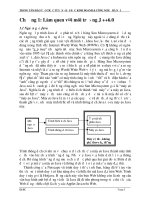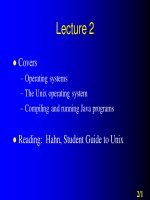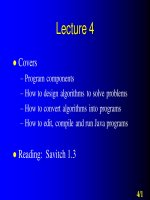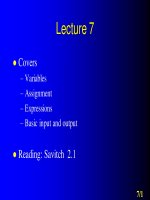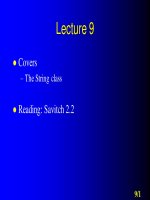Giáo trình Java cơ bản 20
Bạn đang xem bản rút gọn của tài liệu. Xem và tải ngay bản đầy đủ của tài liệu tại đây (434.4 KB, 34 trang )
Lecture 20
Covers
–
–
–
–
Information hiding and encapsulation
Access modifiers
Class interfaces
javadoc
Reading: Savitch 4.2, Appendix 9
20/1
Lecture overview
Access Mode and Encapsulation
Information Hiding
The javadoc Utility (to generate
documentation on classes)
20/2
► Access modifiers and
encapsulation
20/3
Access modifiers
In defining an attribute or a method, we can
use the following access modifiers to
control how the attribute or the method can
be accessed by other classes
– public
– protected
– private
20/4
Access modes
These access modifiers give rise to four
access modes
–
–
–
–
public
package (or default access mode)
protected
private
20/5
Access modifiers / modes
Mode
Modifier Accessible to
public
public
Every class
protected protected Subclasses and classes
in the same package
package NONE Classes in the same package
private private The current class only
20/6
Encapsulation issue
Access modifiers are closely related to the issue of
encapsulation
Encapsulation is often described as the “mechanism
to put methods and attributes together”
– This explanation fails to explain the significance or
purpose of encapsulation
The purpose of encapsulation is to enable the object
to exercise proper control over its state
In particular, to protect the state’s integrity
20/7
Example - digital clock
Model a digital clock (that has hours and
minutes)
Want hours between 0 and 23, and minutes
between 0 and 59
Should write the constructors and mutators
carefully to enforce the valid ranges
20/8
A design
Attributes: hours, minutes
Constructor: no argument; set hours and minutes to 0
Mutator methods (methods that change the state of
an object as defined by its attributes):
setHours(int hrs)
setMinutes(int mns)
tick( ) // a minute has passed
Accessor methods (considered later)
20/9
A (wrong) choice of access
modes
Suppose we choose to let the attributes have
public access mode
public class DigitalClock
{
public int hours;
public int minutes;
public DigitalClock( )
{
hours = 0;
minutes = 0;
}
20/10
public void setHours(int hrs)
{
if (0 < = hrs && hrs <= 23)
{
hours = hrs;
}
else
{
hours = 0;
}
}
public void setMinutes(int mns)
{
// similar
}
20/11
public void tick( )
{
minutes ++;
if (minutes == 60)
{
minutes = 0;
hours ++;
}
if (hours == 24)
{
hours = 0;
}
}
public String toString( ){ }
// other accessor methods
}
20/12
Consequences
Despite our effort to keep hours and
minutes in the valid ranges, other classes
can easily set them to invalid values
For example, the class DigitalClockTest can
do this with the statement
clock.hours = -100;
20/13
Consequences
The previous violation is a consequence of
the public access mode
Recall that public attributes can be directly
accessed by other classes
Hence class DigitalClockTest can directly
access and change hours and minutes at will
20/14
Encapsulation
Only the private access mode offers proper
protection
In other words, a DigitalClock object has proper
control over its state (in particular, the state is
ensured to be valid)
We say that objects are well-encapsulated when
their details (particularly instance attributes) are
hidden in this way - access and change must be
through the class interface (its public operations)
20/15
Accessor methods
We may provide methods to make the values of
hours and minutes available (as read-only
properties) to other classes
They are usually known as accessor methods
The use of accessor methods
– Enhances the usefulness of the class
– Will not do any harm - the principle of encapsulation is
still enforced
The name of accessor methods usually starts with
the word get, so frequently accessor methods are
referred to as get methods
20/16
Code for accessor methods
public int getHours( )
{
return hours;
}
public int getMinutes( )
{
return minutes;
}
20/17
Mutator methods
Sometimes we have a legitimate reason for
allowing a user of our class to change the
value of an attribute
The name of mutator methods usually starts
with the word set, so frequently mutator
methods are referred to as set methods
20/18
General rule
To enforce the principle of encapsulation
– Chose private access mode for attributes
– Provide accessor methods to make the attributes
available in the read-only mode to other classes
20/19
Access modifiers and UML
In UML Class diagrams, the access
modifier can be specified for each attribute
and method
+ indicates public
- indicates private
If no access modifiers are specified, one
would assume that attributes are private and
methods are public
20/20
Class diagram
BankAccount
- String accountNumber
- String customerName
- double balance
+ BankAccount(String accNo, String custName)
+ void deposit(double amount)
+ void withdraw(double amount)
+ double getBalance( )
+ String toString( )
20/21
General rule
To enforce the principle of encapsulation
– Chose private access mode for attributes
– Provide accessor methods to make the attributes
available in the read-only mode to other classes
20/22
► Information hiding
20/23
Encapsulation
(and information hiding)
Encapsulation
– A form of information hiding
– Hide the details of a class and provide an
interface to the class which controls access to
the object
20/24
Information hiding
Is a means to
– Reduce the “cognitive load” on a programmer
Includes
– Designing classes so they can be used without
needing to understand how they are
programmed
20/25
